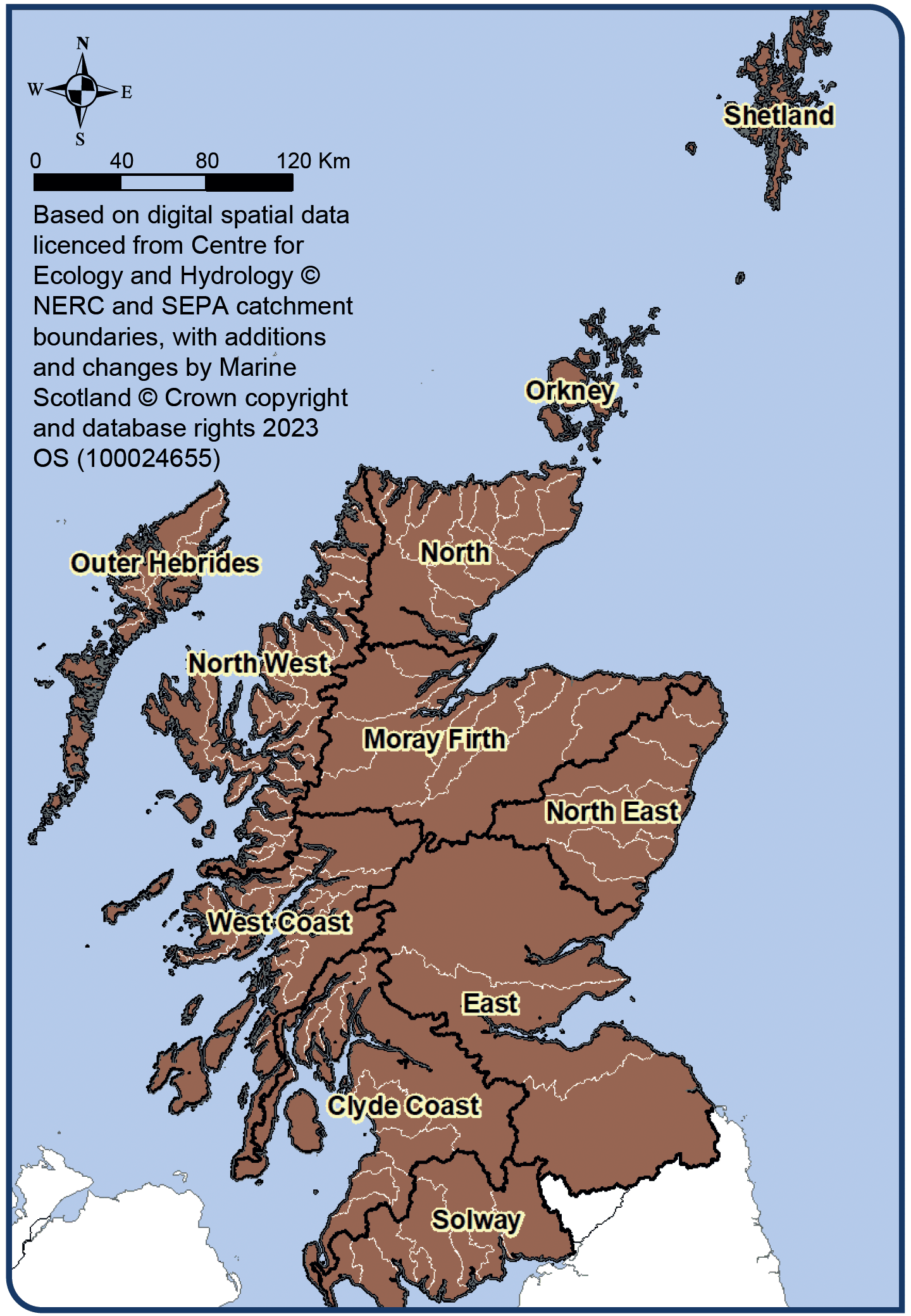Collecting the Marine Scotland salmon and sea trout fishery statistics
Describes how the annual Marine Scotland salmon and sea trout fishery statistics are collected and made available.
Collecting the Marine Scotland salmon and sea trout fishery statistics
Introduction
Salmon and sea trout fishery statistics are obtained from returns made in response to an annual questionnaire sent to the proprietors or occupiers of salmon and sea trout fisheries under the provisions of section 64 of the Salmon and Freshwater Fisheries (Consolidation) (Scotland) Act 2003.
Fishery districts and regions
For the purposes of these statistics, Marine Scotland (MS) combine data geographically into 109 Districts which are further aggregated into 11 regions. Districts correspond either to a single river catchment together with adjacent coast or to groups of neighbouring river catchments and associated coastline. Where Districts have more than one river draining to the coast, these are split into Assessment Areas for the purpose of the annual assessment of stocks and development of Conservation of Salmon (Scotland) Regulations. Outflow points for Assessment Areas are available in the consultation for the proposed river gradings.
The blank area on the map below corresponds to that part of the Border Esk catchment located in Scotland. Functions relating to the management of salmon and sea trout in respect of this catchment rest with UK Ministers. Similarly, the parts of the Tweed catchment that lie in England are the responsbility of Scottish Ministers for salmon and sea trout management purposes. Interactive maps of the Statistical Regions, Districts and assessment areas are available via the Marine Scotland Information pages for Salmon and Sea Trout Fishing.

Regions (black boundary) and disticts (white boundary)
The Fisheries
All Scottish salmon and sea trout fisheries fall into three broad categories:
- Fixed Engine - fisheries are generally restricted to the coast where they must be set outside estuary limits. Poke nets and haaf nets are restricted to the Solway Region where they may be fished on the coast or within estuaries. Historically, cruives operated within rivers and were classified as fixed engines. No cruives are currently active.
- Net and Coble - fisheries generally operate in estuaries and the lower reaches of rivers.
- Rod and Line - fisheries comprise recreational angling activities which generally take place within rivers.
Catches
Currently each fishery is required to provide the numbers and total weights of both wild and farmed multi sea-winter (MSW) and one sea-winter (1SW) salmon, as well as sea trout. This includes caught and retained fish and those fish caught and released back into the river. Data is published as reported. No attempt is made to correct for 'grilse error', the mis-classification of fish between 1SW salmon (grilse) and MSW salmon categories.
Fishing effort
Fisheries are also required to provide monthly fishing effort data. Fixed engine fisheries report minimum and maximum numbers of traps deployed while net and coble fisheries report the minimum and maximum number of crews that operated. This information is used to derive the median monthly effort data. Netting effort data from the Solway region (haaf and poke nets) is omitted when calculating the national index for fixed engine fishing effort. Rod fisheries have reported rod days effort per month since 2019.
Continuity of the data collected
Aggregate monthly data has been collected annually from Scottish salmon and sea trout fisheries since 1952.
The number and weight of wild MSW and 1SW salmon caught and retained by both net and rod fisheries have been collected throughout the time series as has netting effort. Between 1952 and 1964, single values were reported each month for both the numbers of traps and crew deployed and the numbers of individuals employed in netting. Since 1965, however, net fisheries have been required to report the maximum and minimum numbers for each metric.
The number and weight of sea trout caught and retained by both net and rod fisheries have also been collected throughout the time series. Between 1952 and 1993, fisheries were simply required to report sea trout taken as a single category. Between 1994 and 2003, fisheries were required to report sea trout weighing less than 0.5 kg separately from those weighing greater than 0.5kg. During both periods, any reports of finnock catches were disregarded.
Finnock are sea trout which have spent less than a year at sea before making their first return to fresh water. They may also be known as whitling or herling. Since 2004, fisheries have been required to report finnock catches and other sea trout as separate categories. Marine Scotland routinely provide a historical time series of sea trout data aggregated over all categories except those reported as finnock, which are provided separately. Since 1994, the number and weight of farmed salmon taken by net and rod and the number and weight of salmon and sea trout released by the rod fishery has been collected. Collection of the number and weight of released net caught fish began in 2021.
Quality Assurance
Reported data is verified against a series of checks. Where necessary, the data is referred back to the person completing the questionnaire for clarification. The information published, however, is the summation of the reported data. No attempt is made to correct that data for non-returns or incomplete coverage of existing fisheries. Return rates of catch forms since 1997 are available for download.
Provision of Information
Since September 2011, salmon and sea trout fishery data has been published as Scottish Government Official Statistics.
The associated summary data may be downloaded from the Marine Scotland data website.
The information available for download is the best available at the time of publication. Our records are amended when further information becomes available and updated annually in early summer when the statistics for the most recent fishing season are published.
Contact us
Scottish Government Marine ScotlandFreshwater Fisheries Field Station
Inchbraoch House
South Quay
Ferryden
Montrose
DD10 9UA
Telephone: 0131 244 4500,
e-mail: ms.catchform@gov.scot
Contact
Email: ms.catchform@gov.scot
There is a problem
Thanks for your feedback